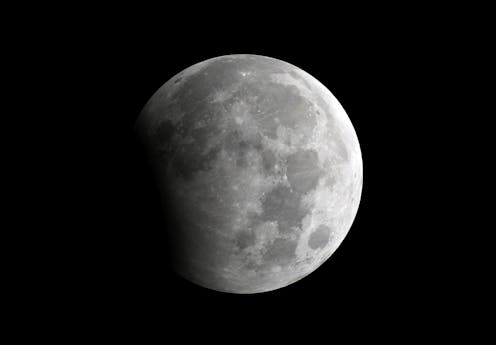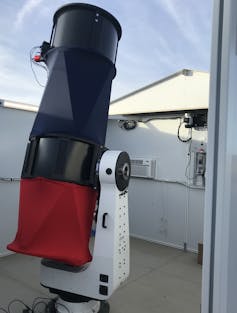Scientists and space agencies are shooting for the Moon -- 5 essential reads on modern lunar mission
Chandrayaan-3’s successful landing on the Moon made 2023 a big year for lunar exploration, and future years will come with even more discoveries.

The year 2023 proved a big one for lunar science. India’s Chandrayaan-3 spacecraft landed near the south pole of the Moon, a huge accomplishment for a country relatively new to the space scene, especially after its Chandrayaan-2 craft crashed in 2019.
At the same time, NASA’s been gearing up for a host of Moon-related missions, including its Artemis program. In 2023, the agency gained nine signatories to the Artemis Accords, an international agreement for peaceful space exploration, for a total of 32 countries that have signed so far.
As Georgia Tech’s Mariel Borowitz explains, the U.S. now has widespread bipartisan political support for spacefaring – for the first time since the 1970s – and returning missions to the Moon is the first natural target.
Here are five stories that The Conversation U.S. has published over the past year about lunar exploration, including why people want to go back to the Moon, what Chandrayaan-3 found during its initial foray across the lunar surface and the ever-growing problem of lunar space junk.
1. Why shoot for the Moon?
Missions to the Moon hold potential benefits for a variety of sectors, including commercial, military and geopolitical.
“Ever since humans last left the Moon in 1972, many have dreamed about the days when people would return. But for decades, these efforts have hit political roadblocks,” wrote Borowitz. “This time, the United States’ plans to return to the Moon are likely to succeed – it has the cross-sector support and the strategic importance to ensure continuity, even during politically challenging times.”
While some of these potential uses are incredibly far off – from mining the Moon for resources to sending out military satellites to orbit around the Moon – missions to the Moon in the near term will help inform scientists and stakeholders of future possibilities.
2. Searching for sulfur
India’s Chandrayaan-3 lander touched down on the Moon’s surface, just a few miles away from the lunar south pole, in late August 2023.
Its rover, called Pragyan, took measurements of the lunar surface and found the soil near the south pole contains a surprise – sulfur.
As Jeffrey Gillis-Davis, a physicist at Washington University in St. Louis, wrote, future Moon missions or a future Moon base could use lunar sulfur as an ingredient in everything from fuel and fertilizer to concrete.
Read more: Chandrayaan-3's measurements of sulfur open the doors for lunar science and exploration
3. Water in ice
But sulfur’s not the only resource the lunar south pole could have to offer. For several years, scientists have predicted that the lunar south pole might have water in the form of ice. And Chandrayaan-3’s sulfur discovery gives scientists more insight into how and how recently ice might have formed on the surface.
Comets or volcanic activity could have brought water to the Moon years ago. If volcanic activity is the culprit for water’s appearance, scientists would also expect to see sulfur in higher levels, wrote Paul Hayne, an assistant professor of astrophysical and planetary sciences at the University of Colorado Boulder.
A host of future missions to the Moon, including NASA’s VIPER mission planned for 2024, will continue to investigate where ice could be hiding on the Moon.
4. Moon debris
With all the Moon missions, both current and upcoming, some experts have raised concerns about the increased space junk in the “cislunar space” – or the space between Earth and the Moon and around the Moon.
NASA doesn’t currently track the space junk left behind from its missions, and this lack of oversight has many people worried.

One team at the University of Arizona has started building a catalog of debris left in this space. Team members started off by identifying a few large objects, and as their methods got better, they were able to see objects as small as a cereal box. The team hopes this work will one day improve the sustainability of future lunar missions.
“While there is still a long way to go, these efforts are designed to ultimately form the basis for a catalog that will help lead to safer, more sustainable use of cislunar orbital space as humanity begins its expansion off of the Earth,” writes Vishnu Reddy, a professor of planetary science at the University of Arizona.
5. Future flyers
Early this year, NASA announced who will make up the crew of their Artemis II mission. Set for late 2024, Artemis II will fly by the Moon and test the technology and equipment planned for use in future missions. It will also mark the first time people are close to the lunar surface in over 50 years.

Three of the four crew members have spent time in space, with the fourth having spent lots of time in spaceflight simulations. Each started their careers as a military pilot, just like all the astronauts of the Apollo missions. But this crew represents more racial and gender diversity than the astronauts of the Apollo era.
“Unlike the Apollo program of the 1960s and 1970s, with Artemis, NASA has placed a heavy emphasis on building a politically sustainable lunar program by fostering the participation of a diverse group of people and countries,” wrote Wendy Whitman Cobb, a professor of strategy and security studies at Air University.
This story is a roundup of articles from The Conversation’s archives.
Read These Next
What’s at stake in Trump’s executive order aiming to curb state-level AI regulation
In the absence of comprehensive federal AI regulation, states have stepped in. The Trump administration,…
The Bible says little about Jesus’ childhood – but that didn’t stop medieval Christians from enjoyin
Legends about Jesus’ early years that circulated in medieval Europe often drew on apocryphal texts.
Data centers need electricity fast, but utilities need years to build power plants – who should pay?
How many data centers will be built – and how much electricity they’ll need – is uncertain. Being…





